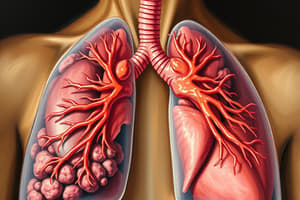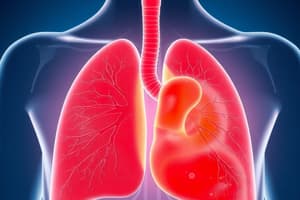Podcast
Questions and Answers
During a normal exhalation of 500 mL, what volume of air is typically considered 'fresh' air from the conducting zone that did not participate in gas exchange?
During a normal exhalation of 500 mL, what volume of air is typically considered 'fresh' air from the conducting zone that did not participate in gas exchange?
- 0 mL
- 350 mL
- 150 mL (correct)
- 500 mL
At the end of a normal expiration, approximately how much 'stale' air remains within the respiratory zone?
At the end of a normal expiration, approximately how much 'stale' air remains within the respiratory zone?
- 500 mL
- 150 mL
- 2200 mL (correct)
- 2350 mL
During inhalation, what is the first volume of air entering the alveoli, and from where does it originate?
During inhalation, what is the first volume of air entering the alveoli, and from where does it originate?
- 150 mL of stale air from the conducting zone (correct)
- 350 mL of stale air from the conducting zone
- 150 mL of fresh air from the atmosphere
- 350 mL of fresh air from the atmosphere
Why does the gas composition in the alveoli change only slightly with each breath?
Why does the gas composition in the alveoli change only slightly with each breath?
At the end of inspiration, which volume represents the functional residual capacity?
At the end of inspiration, which volume represents the functional residual capacity?
If a person inhales a tidal volume of 600 mL, assuming the anatomical dead space remains constant, how much 'fresh' air reaches the respiratory zone?
If a person inhales a tidal volume of 600 mL, assuming the anatomical dead space remains constant, how much 'fresh' air reaches the respiratory zone?
What happens to the 150 mL representing anatomical dead space during exhalation?
What happens to the 150 mL representing anatomical dead space during exhalation?
How would an increase in the functional residual capacity (FRC) affect the change in alveolar gas composition with each breath, assuming tidal volume remains constant?
How would an increase in the functional residual capacity (FRC) affect the change in alveolar gas composition with each breath, assuming tidal volume remains constant?
Which volume remains constant regardless of changes affecting respiratory volumes?
Which volume remains constant regardless of changes affecting respiratory volumes?
A patient with a pulmonary disease has an increased anatomical dead space. Assuming their tidal volume remains normal, what is the most likely consequence?
A patient with a pulmonary disease has an increased anatomical dead space. Assuming their tidal volume remains normal, what is the most likely consequence?
Flashcards
Anatomic dead space
Anatomic dead space
The volume of air in the conducting zone that doesn't participate in gas exchange.
Stale air (end exhalation)
Stale air (end exhalation)
Air in conducting zone at the end of exhalation.
Air in respiratory zone (end exhalation)
Air in respiratory zone (end exhalation)
The volume of 'stale' air remaining in the respiratory zone after expiration.
First air inhaled
First air inhaled
Signup and view all the flashcards
Fresh air volume (inhalation)
Fresh air volume (inhalation)
Signup and view all the flashcards
Fresh air (end inspiration)
Fresh air (end inspiration)
Signup and view all the flashcards
Study Notes
Anatomic Dead Space During Exhalation
- During a normal tidal volume exhale of 500 mL, the first 150 mL is "fresh" air trapped in the conducting zone.
- The next 350 mL is "stale" air where gas exchange occurred in the respiratory zone.
Air Composition at the End of Expiration
- At the end of an expiration, 150 mL of "stale" air remains in the conducting zone.
- About 2200 mL of "stale" air remains in the respiratory zone.
Anatomic Dead Space During Inhalation
- When inhaling a normal tidal volume of 500 mL, the initial 150 mL is "stale" air from the conducting zone.
- The subsequent 350 mL is "fresh" air drawn from the atmosphere.
- The gas composition in the alveoli experiences minimal change, as 350 mL of fresh air combines with 2350 mL of stale air.
Air Composition at the End of Inspiration
- Following an inspiration, 150 mL of "fresh" air remains in the conducting zone of the lungs.
- 2700 mL of "stale" air is in the respiratory zone.
- The functional residual capacity of "stale air" is equivalent to 2200 ml.
- Normal tidal volume is 500 mL, comprised of 150 mL of "stale" air and 350 mL of "fresh" air.
Studying That Suits You
Use AI to generate personalized quizzes and flashcards to suit your learning preferences.




